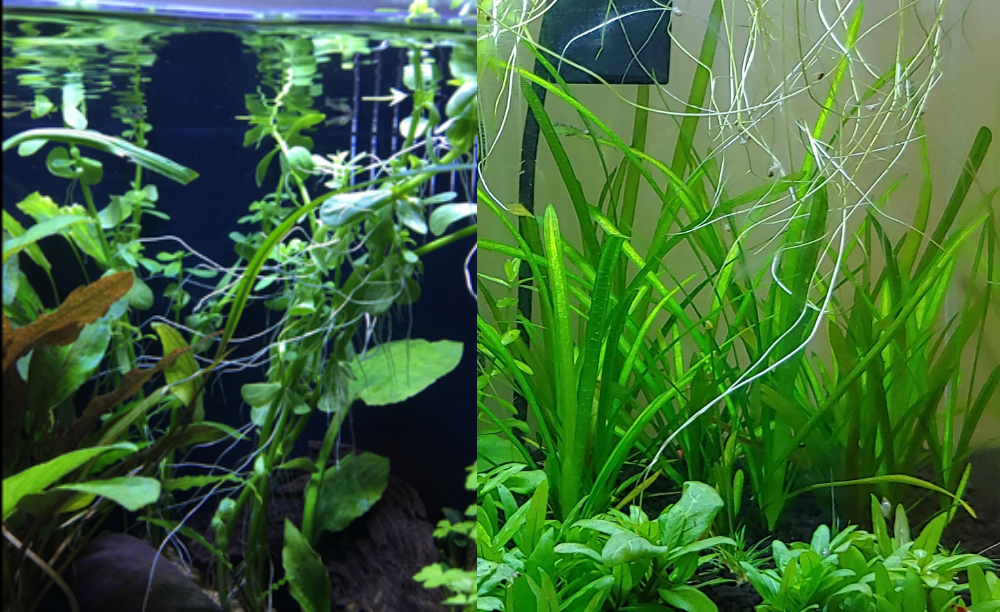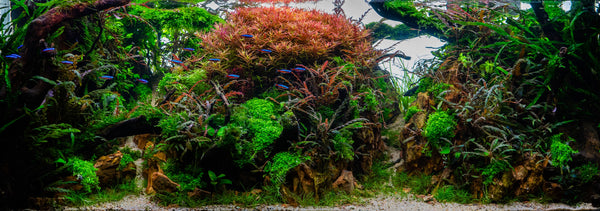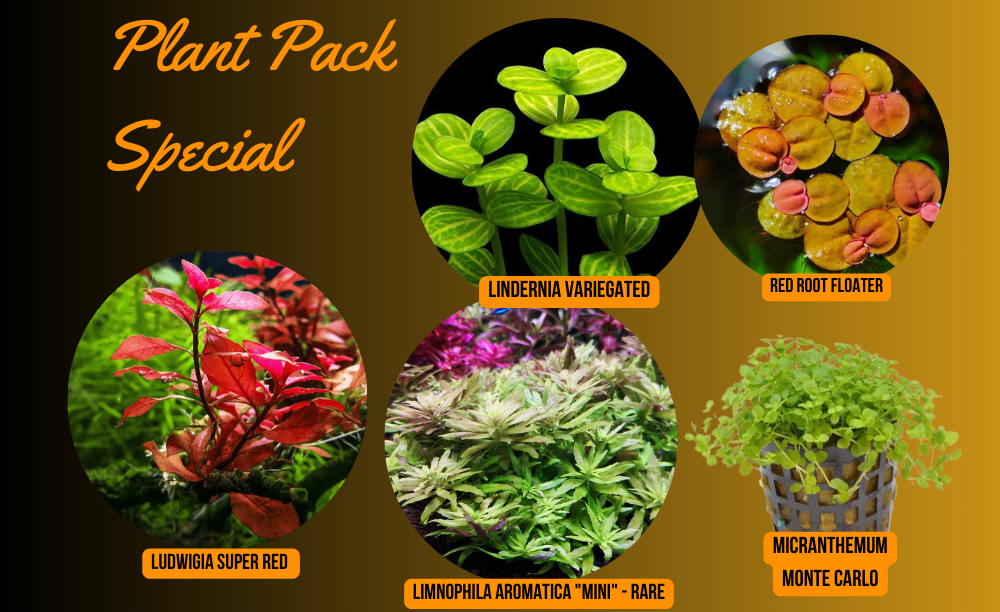Your Cart is Empty
we are now CLOSED FOR OUR ANNUAL BREAK
ANY NEW ORDERS WILL NOT BE SENT UNTIL EARLY JANUARY
***FREE SHIPPING ON ORDERS OVER $200***
we are now CLOSED FOR OUR ANNUAL BREAK
ANY NEW ORDERS WILL NOT BE SENT UNTIL EARLY JANUARY
***FREE SHIPPING ON ORDERS OVER $200***
Store

Aerial Roots
3 min read
Aerial Roots & Stem Plants
If you’ve ever kept stem plants in your aquarium, at some point you have likely noticed fine white roots growing sideways from stems into the water column. Sometimes stems put out quite a few! They’re unsightly, and might make you wonder if your plant is getting all the nutrients it needs. So why do they form, and do you need to do anything about them?
Making space
One reason aerial roots from is to allow a plant to claim space. If planted in your aquarium with plenty of space around it, a stem forms aerial roots at leaf internodes. These stems spread out horizontally, eventually finding substrate if left undisturbed. New stems usually then grow from the internodes, allowing the plant to “bush out”. Even if the roots don’t find substrate, they still absorb nutrients for these new internode stems to grow. The plant is essentially trying to claim the biggest area it can!
Propagating
Another reason aerial roots form is to allow the plant to quickly regrow anew if a portion is broken off or if conditions in its current area are not favourable. In natural systems this can happen regularly as stems are damaged by external factors, lighting is affected or nutrients are exhausted. The stem portion is swept downstream and eventually finds a spot to settle, where the aerial roots become the main roots. A new plant forms and spreads!
Stems growing horizontally at the water’s surface usually start growing aerial roots to achieve exactly this function.
Trimming
As mentioned earlier, aerial roots often form at stem internodes, where new stems branch out. Trimming the top of a stem plant encourages the stem to branch at that point, encouraging more aerial roots to grow in response. The more you trim, the more branching and therefore more aerial roots will form.
Nutrient Deficiency
Aerial roots can also form in nutrient deficient plants. If roots in the substrate can’t absorb enough nutrients for healthy growth, the plant uses aerial roots in an attempt to gather them from the water column instead. If this is happening, the plant will also be exhibiting poor leaf growth, as leaves can absorb nutrients from the water as well.
Avoiding Aerial Roots
So we’ve learned that aerial roots are not usually a sign of something wrong and are more likely the plant exhibiting natural functions in an effort to spread out and multiply.
But, the fact remains that aerial roots are messy to look at – so how do you convince your plant it doesn’t need them?
Plant in tighter bunches – if your stems have less horizontal room to spread, they’ll focus on growing upwards toward the light instead of spreading out. Plant in tighter bunches to make your stems compete for height.
Don’t let your plants grow to the surface – Stems typically start growing horizontally when they reach the surface and aerial roots pop out. Keep on top of trimming and it’s not a problem!
Replant tops, discard bottoms – When you do trim, replant the healthy tops and discard the old stems. This allows for vibrant, healthy stems and greatly decreases the chance of aerial roots forming.
Fertilise – If your plant leaves are showing signs of deficiency along with formation of aerial roots, it’s time to increase the amount of fertiliser you’re dosing. Trim and replant stem tops, fertilise regularly and keep an eye out for healthy new growth.
Finally, you can also simply trim off aerial roots. If your plant is otherwise healthy it won’t have any detrimental effect. But, if you can address the root causes, you can avoid aerial roots altogether.
From The LCA Team
Every Solution For Your Aquarium
If you’ve ever kept stem plants in your aquarium, at some point you have likely noticed fine white roots growing sideways from stems into the water column. Sometimes stems put out quite a few! They’re unsightly, and might make you wonder if your plant is getting all the nutrients it needs. So why do they form, and do you need to do anything about them?
Making space
One reason aerial roots from is to allow a plant to claim space. If planted in your aquarium with plenty of space around it, a stem forms aerial roots at leaf internodes. These stems spread out horizontally, eventually finding substrate if left undisturbed. New stems usually then grow from the internodes, allowing the plant to “bush out”. Even if the roots don’t find substrate, they still absorb nutrients for these new internode stems to grow. The plant is essentially trying to claim the biggest area it can!
Propagating
Another reason aerial roots form is to allow the plant to quickly regrow anew if a portion is broken off or if conditions in its current area are not favourable. In natural systems this can happen regularly as stems are damaged by external factors, lighting is affected or nutrients are exhausted. The stem portion is swept downstream and eventually finds a spot to settle, where the aerial roots become the main roots. A new plant forms and spreads!
Stems growing horizontally at the water’s surface usually start growing aerial roots to achieve exactly this function.
Trimming
As mentioned earlier, aerial roots often form at stem internodes, where new stems branch out. Trimming the top of a stem plant encourages the stem to branch at that point, encouraging more aerial roots to grow in response. The more you trim, the more branching and therefore more aerial roots will form.
Nutrient Deficiency
Aerial roots can also form in nutrient deficient plants. If roots in the substrate can’t absorb enough nutrients for healthy growth, the plant uses aerial roots in an attempt to gather them from the water column instead. If this is happening, the plant will also be exhibiting poor leaf growth, as leaves can absorb nutrients from the water as well.
Avoiding Aerial Roots
So we’ve learned that aerial roots are not usually a sign of something wrong and are more likely the plant exhibiting natural functions in an effort to spread out and multiply.
But, the fact remains that aerial roots are messy to look at – so how do you convince your plant it doesn’t need them?
Plant in tighter bunches – if your stems have less horizontal room to spread, they’ll focus on growing upwards toward the light instead of spreading out. Plant in tighter bunches to make your stems compete for height.
Don’t let your plants grow to the surface – Stems typically start growing horizontally when they reach the surface and aerial roots pop out. Keep on top of trimming and it’s not a problem!
Replant tops, discard bottoms – When you do trim, replant the healthy tops and discard the old stems. This allows for vibrant, healthy stems and greatly decreases the chance of aerial roots forming.
Fertilise – If your plant leaves are showing signs of deficiency along with formation of aerial roots, it’s time to increase the amount of fertiliser you’re dosing. Trim and replant stem tops, fertilise regularly and keep an eye out for healthy new growth.
Finally, you can also simply trim off aerial roots. If your plant is otherwise healthy it won’t have any detrimental effect. But, if you can address the root causes, you can avoid aerial roots altogether.
From The LCA Team
Every Solution For Your Aquarium
Subscribe
Sign up to get the latest on sales, new releases and more …

Join Us
Join our Facebook group and benefit from the knowledge of
Australia’s largest community of planted aquarium enthusiasts!







